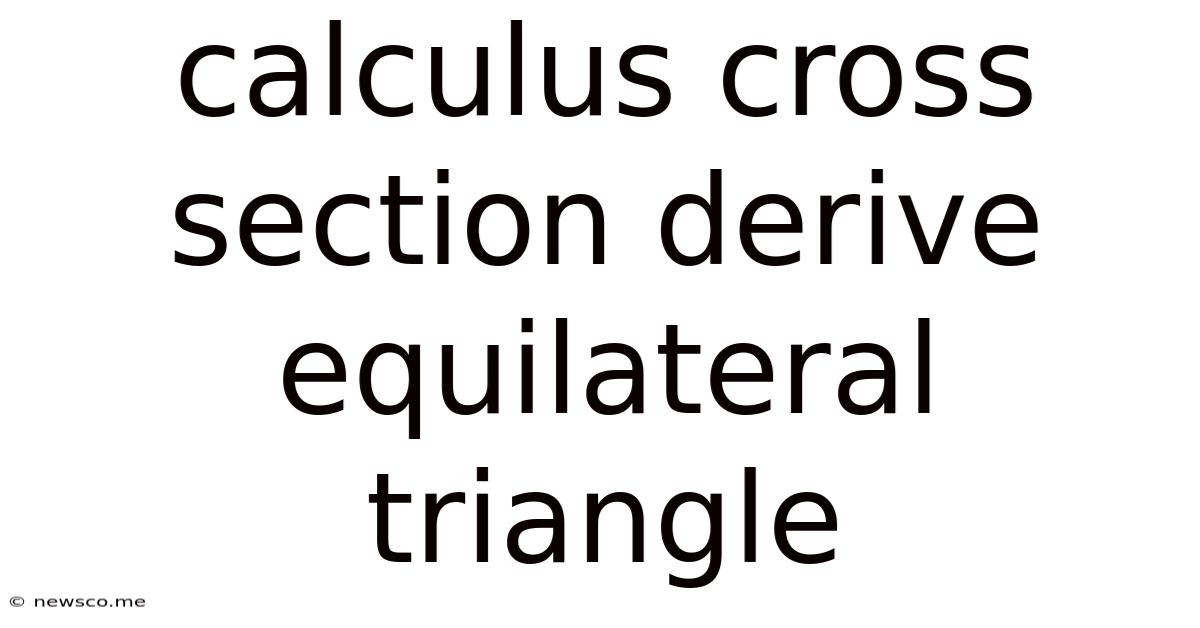Calculus Cross Section Derive Equilateral Triangle
News Co
Mar 29, 2025 · 5 min read

Table of Contents
Calculating the Volume of a Solid with an Equilateral Triangle Cross-Section
Calculus provides powerful tools for solving complex geometric problems. One such application is determining the volume of a solid with a known cross-sectional area. This article delves into a specific example: calculating the volume of a solid whose cross-sections perpendicular to the x-axis are equilateral triangles. We'll explore the derivation process step-by-step, highlighting key concepts and techniques.
Understanding the Problem
Imagine a three-dimensional solid extending along the x-axis. Each cross-section of this solid, taken perpendicular to the x-axis, is an equilateral triangle. The size of the equilateral triangle varies as we move along the x-axis; it's defined by a function, let's call it f(x). This function determines the side length of the equilateral triangle at any given x-coordinate. Our goal is to find the total volume of this solid, given the function f(x) and the interval [a, b] along the x-axis.
Deriving the Formula for the Area of an Equilateral Triangle
Before we tackle the volume calculation, we need a formula for the area of an equilateral triangle in terms of its side length.
Let's consider an equilateral triangle with side length s. We can divide this triangle into two 30-60-90 right-angled triangles. The height (h) of the equilateral triangle can be found using trigonometry:
h = s * sin(60°) = s * (√3/2)
The area (A) of the equilateral triangle is given by:
A = (1/2) * base * height = (1/2) * s * h = (1/2) * s * (s√3/2) = (√3/4) * s²
This formula is crucial because it connects the side length of our equilateral triangle cross-section (s) to its area (A). Since the side length is defined by our function f(x), we can write the area of the cross-section at a given x as:
A(x) = (√3/4) * [f(x)]²
Applying Integral Calculus to Find the Volume
The key to finding the total volume lies in integrating the area function A(x) over the interval [a, b]. We can approximate the volume by slicing the solid into thin cylinders, each with a cross-sectional area A(x) and thickness Δx. The volume of each slice is approximately A(x)Δx. As Δx approaches zero, this approximation becomes increasingly accurate, and we arrive at the exact volume using integration:
V = ∫[a to b] A(x) dx
Substituting our area formula, we obtain:
V = ∫[a to b] (√3/4) * [f(x)]² dx
This formula is the fundamental result: It gives the volume of a solid whose cross-sections perpendicular to the x-axis are equilateral triangles with side length defined by the function f(x) over the interval [a, b].
Example: Calculating Volume for a Specific Function
Let's consider a concrete example. Suppose the side length of our equilateral triangle cross-sections is given by the function:
f(x) = x²
And the interval along the x-axis is [0, 2]. We can now calculate the volume:
V = ∫[0 to 2] (√3/4) * (x²)² dx
V = (√3/4) ∫[0 to 2] x⁴ dx
Using the power rule for integration:
∫ xⁿ dx = (xⁿ⁺¹)/(n+1) + C
We get:
V = (√3/4) * [(x⁵)/5] evaluated from 0 to 2
V = (√3/4) * [(2⁵)/5 - (0⁵)/5]
V = (√3/4) * (32/5)
V = (8√3)/5
Therefore, the volume of this solid is (8√3)/5 cubic units.
Variations and Extensions
The method described above can be adapted to various scenarios:
1. Different Cross-Sectional Shapes:
The core principle remains the same: find the area of the cross-section as a function of x, and integrate that area function over the specified interval. You could use this method for solids with square, circular, or any other shape for the cross-sections. The only change would be the area formula used in the integral.
2. Cross-sections Perpendicular to the y-axis:
If the cross-sections are perpendicular to the y-axis, you would simply integrate with respect to y instead of x. The area function would then be expressed in terms of y, and the limits of integration would be the y-coordinates defining the extent of the solid along the y-axis.
3. More Complex Functions:
The function f(x) defining the side length of the cross-section can be significantly more complex. The integral might require more advanced integration techniques, such as substitution, integration by parts, or partial fraction decomposition. Numerical integration methods could also be employed if an analytical solution proves too challenging.
4. Three-Dimensional Coordinate Systems:
While we focused on solids aligned with the x-axis, this methodology can be generalized to solids defined in three-dimensional space, involving multiple variables and potentially double or triple integrals.
Conclusion
Calculating the volume of a solid using calculus, especially one with equilateral triangle cross-sections, is a beautiful application of integral calculus. The process involves understanding the geometry of the cross-sections, deriving an appropriate area formula, and then integrating that area function to obtain the total volume. This technique can be extended to diverse shapes and functions, expanding the range of problems that can be solved using these powerful mathematical tools. Remember, mastery of calculus requires practice and a deep understanding of its fundamental principles. The more complex the function f(x) defining the cross-sectional area, the more advanced integration techniques you might need to employ. But the core principle of integrating the area function remains consistent and powerful. This example illustrates the elegance and practical applicability of calculus in solving real-world problems.
Latest Posts
Related Post
Thank you for visiting our website which covers about Calculus Cross Section Derive Equilateral Triangle . We hope the information provided has been useful to you. Feel free to contact us if you have any questions or need further assistance. See you next time and don't miss to bookmark.